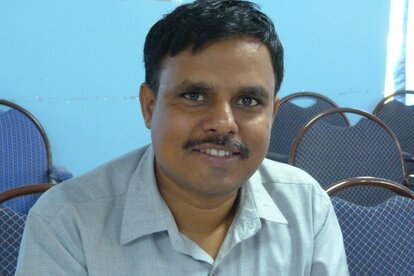The heat of the day is rising as we jolt along dirt tracks through fields tall and green with ripening paddy. Ahead are the first hills marking the point at which the flat Terai plains meet the beginning of the Himalayas, and rivers flowing from them spread out into meandering channels. The Kuinetar suspension bridge that we are visiting crosses one such river, the Nunsari khola. It is located exactly at the junction of hills and plain – between the rural municipalities of Miklajung and Chulachuli, on the district border between Morang and Ilam.
Bridge construction
As the engineer providing technical assistance to the Nepal government’s trail bridge programme, I first visited the Kuinetar site on 20 January 2018. A local NGO (service provider) had already identified all the people likely to benefit from the bridge, in total numbering 2,523, and had formed a user group with an elected committee. However, there was a dispute about the bridge location, with many wanting it built a few kilometres further downstream. This would have been technically more complicated, far more expensive, and too long for the community-based approach, which is only applicable for trail bridges with a span of less than 120m. In the presence of the elected chairpersons of both the ward and the rural municipality, I explained the construction procedure and suggested the current site, which has a span of 119.8m. It was the user committee themselves who took charge of its construction, overseeing the budget and providing the labor. It was completed on 13 July this year.
Shortening journeys, saving lives
Joining us as we walk across the bridge are Rudra Basnet, the user group chairman; Bikendra Rai, who has been appointed bridge warden (on the right in the photo); and Bharta Kumari Rai, one of the regular bridge users (on the left in the photo). Between them, they point out the usual and important advantages of a bridge. Journeys are now much shorter, which is especially important for school children making the daily crossing. Lives are also saved; they claim that in recent times, at least one person a year drowned when trying to cross the river during the monsoon, when it is in flood. But there is an added advantage: all of them have seen the price of their nearby land more than double in the short time since the bridge was built!
A growing tourist attraction
The bridge, by definition, provides a point of crossing for a foot trail. However, it can now be reached by vehicle along a bumpy track that has been built to facilitate access by visitors. Bikendra Rai has a small restaurant which is doing good business, and others are springing up. The area is becoming a meeting spot favored by young couples, and there are also increasing numbers of Indian visitors, curious to see the type of bridges used in the hills. As we chat, two tractors roll up, drawing trailers loaded with bricks. The owner of the bricks, Rajan Nembang, joins the conversation. He is constructing a resort on the far side of the river, confident of the market potential.
Rajan Nembang, Owner of the resort on the far side of the river
Looking to the future
It is important when choosing the location of the bridge to think of the future. Personally, I expect a motorable bridge to be constructed downstream in maybe five years or so. But meanwhile, this bridge will have made a significant contribution to the local economy. Of course, not all bridges have the potential to become a tourist attraction in the way that Kuinetar does. However, it is common for shops and small businesses to spring up at either ends of trail bridges – sometimes growing into thriving markets. This significant way in which trail bridges can contribute to the local economy is rarely fully analyzed or discussed in policy circles.
Technical assistance for the Government of Nepal’s trail bridge program is provided by Helvetas through the support of the Swiss Agency for Development and Cooperation, SDC. For those interested in reading about the way women’s engagement in this program is promoted, see the article in the Journal Rural 21.




